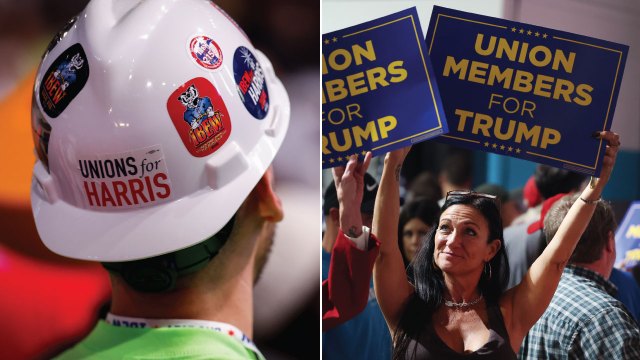
Long seen as a core constituency of the Democratic Party, voters who belong to labor unions are increasingly being courted by both political parties. In this year’s presidential election, the campaigns of former President Donald Trump and Vice President Kamala Harris have made high-profile efforts to win the support of union members. And union workers are a crucial voting bloc in several battleground states that will likely determine who wins the White House.
Here are five facts about unions and union members, drawn from recent Pew Research Center surveys and federal data.
Pew Research Center conducted this analysis to summarize key facts about union members and Americans’ views about unions ahead of the 2024 presidential election. We used data from Center surveys as well as federal data sources to provide insights into union members’ views, such as their party affiliation and vote choice. This data also highlights how Americans view declining union membership and the effect of labor unions on society.
Links to these data sources are available in the text. The links to the Center surveys include information about the questions used, sample sizes and other methodological details.
The majority of union members align with the Democratic Party. About six-in-ten voters who belong to a union (59%) identify with or lean toward the Democratic Party, while about four-in-ten (39%) associate with the GOP, according to 2023 Center survey data.
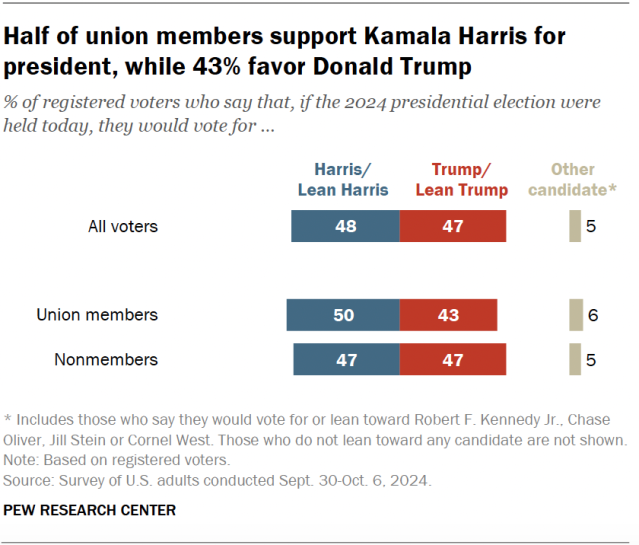
Half of union voters say they would support Harris if the election were held today and 43% say they would support Trump, though this gap is within the survey’s margin of error. Another 6% favor a third-party candidate.
Voters who do not belong to a union are about equally likely to align with either party. And they are equally divided in their presidential vote preferences: 47% would vote for Trump, while 47% would choose Harris. Another 5% would back a third-party candidate.
The share of U.S. workers who belong to a union has fallen over the past four decades. In 1983, 20.1% of American workers were represented by a union. By 2023, 10.0% of U.S. workers were in a union, according to data from the Bureau of Labor Statistics.
As of 2023, union membership was much higher among workers employed in the public sector than the private sector (32.5% vs. 6.0%).
Unionization rates are the lowest in the Southeast and highest in the Northeast, Alaska and Hawaii. A Pew Research Center analysis in 2020 found that 3.1% of workers in North Carolina and 2.9% in South Carolina were unionized, compared with 22.0% in New York, 17.8% in Rhode Island, 17.7% in Alaska and 23.7% in Hawaii.
Majorities of Americans say declining union membership is bad for the country (54%) and for working people (59%), according to a January 2024 Center survey.
Democrats are more likely than Republicans to view the decline in union membership as bad.
- 69% of Democrats say the decline has been bad for the country, and 74% say it has been bad for working people.
- 40% of Republicans say the decline has been bad for the country, and 43% say it has been bad for workers.
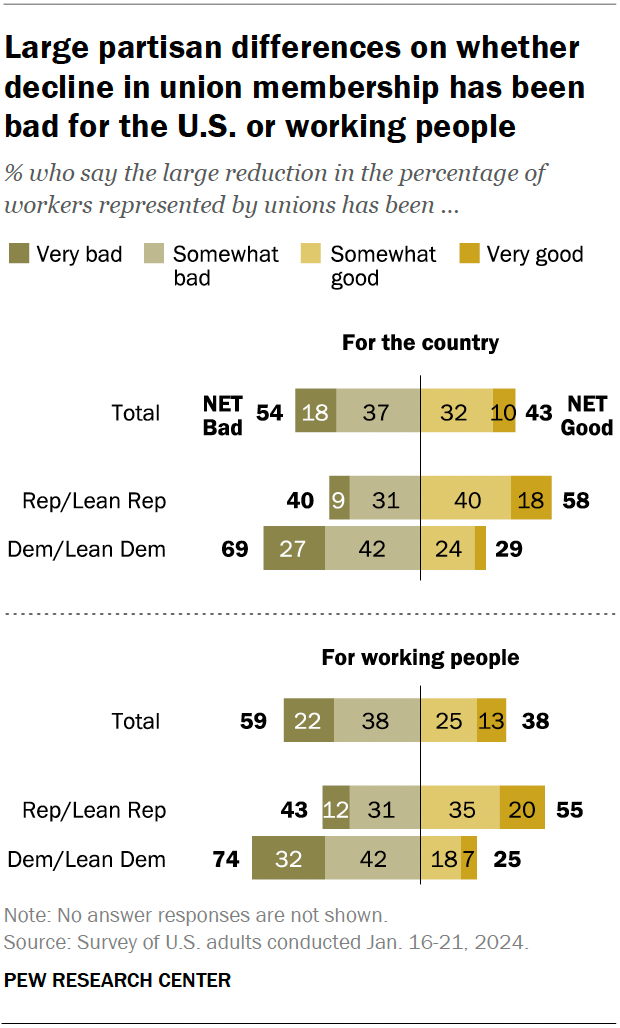
Like voters overall, voters who belong to unions are more likely to say Harris’ policies would be better for union members than Trump’s. While 38% of voters overall say Harris’ policies would make things better for union members, 28% say this about Trump’s policies, according to a September 2024 Center survey.
Among voters who are in a union, 43% say Harris would improve things for union members, while 26% say this about Trump. By contrast, 46% of union voters say Trump’s policies would make things worse for union members. Just 23% of union voters say this about Harris’ policies.
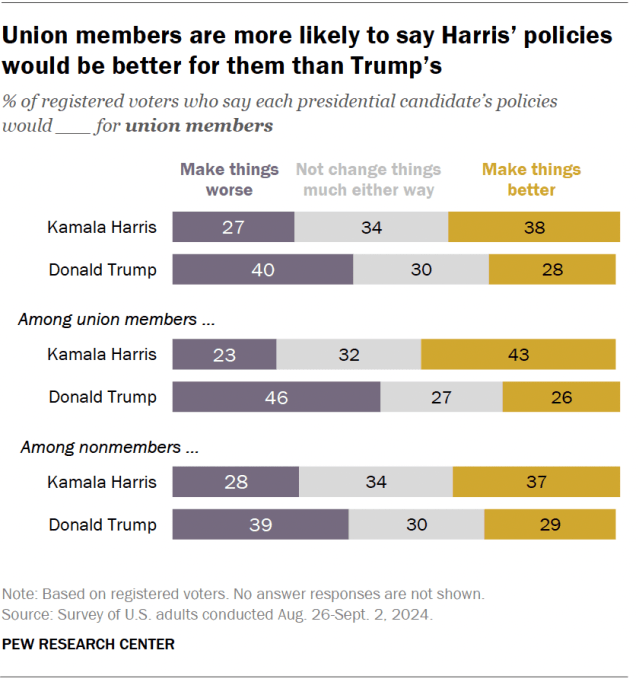
A majority of Americans (55%) say labor unions have a positive effect on the country, while about four-in-ten (41%) say they have a negative impact, according to the Center’s January survey.
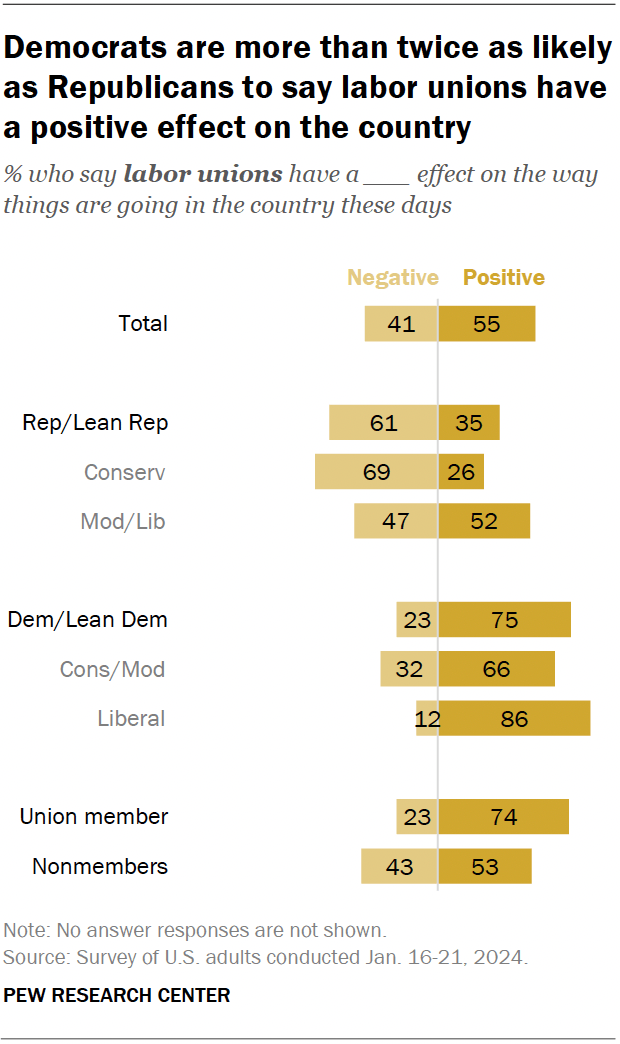
There are large partisan and ideological differences in views of how labor unions impact the country.
- 75% of Democrats believe labor unions have a positive effect on the country, while about a quarter (23%) say they have a negative impact. More Liberal Democrats (86%) than conservative or moderate Democrats (66%) say labor unions affect the country positively.
- 35% of Republicans believe labor unions have a positive effect on American society, compared with 61% who say unions have a negative impact. Negative views are higher among conservative Republicans (69%) than moderates or liberal Republicans (47%).
About three-quarters of union members (74%) say labor unions have a positive effect on the country. A smaller share of nonmembers (53%) say the same.
